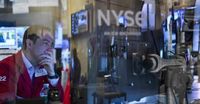Wall Street was in a buoyant mood on August 12, 2025, as U.S. stocks surged to fresh heights after a closely watched inflation report came in largely as expected, fueling investor optimism for imminent interest rate cuts. The S&P 500 rose 1.1%, clinching its 16th record close this year, while the tech-heavy Nasdaq jumped 1.4% to mark its 19th record of 2025, both setting intraday highs during the session, according to The Wall Street Journal. The Dow Jones Industrial Average wasn’t left out of the rally, finishing up 484 points, or 1.1%, more than making up for Monday’s 200-point dip.
What drove this exuberance? The answer lies in the July inflation data. The headline inflation rate held steady at 2.7% year-over-year, while core inflation (which strips out food and energy) ticked up to 3.1%, just a notch above expectations, as reported by TheStreet. This “not too hot, not too cold” scenario was just what investors were hoping for, as it keeps the door wide open for the Federal Reserve to cut rates as soon as September. In fact, traders are now betting on a 94% probability that the Fed will move next month, with odds rising for further cuts in October and December.
“Firms will need to offset the squeeze somehow. That likely implies a continued slowing in employment, hours, cuts to capex or if firms want to roll the dice, a future increase in prices,” Neil Dutta, head of economic research at RenMac, told The Wall Street Journal, highlighting the trade-off between contained inflation and corporate profit margins. For now, though, Wall Street seems content to focus on the positives: lower borrowing costs, potential for business expansion, and a shot in the arm for corporate profits.
But while the inflation numbers were benign, there are signs that tariffs are starting to ripple through the economy. U.S. businesses paid a record $28.4 billion in gross customs receipts to the government in July, a staggering 273% increase from the previous year, according to The Wall Street Journal. That surge is expected to eventually show up in consumer prices, though July’s report offered only hints of that trend. Household furnishings and supplies, a sector sensitive to tariffs, saw prices rise 0.7% in July after a 1% gain in June. Footwear prices were up 1.4%, and coffee prices jumped 2.3%—with the latter poised to climb even higher as new tariffs on Brazilian imports took effect on August 7.
“The effective tariffs rate was a little north of 9% in June. That doubled again in early August,” wrote Diane Swonk, KPMG’s chief economist, in a note cited by The Wall Street Journal. “Tariffs are still working their way into consumer prices.”
Meanwhile, the bond market responded to the inflation news in predictable fashion. The yield on the 2-year Treasury slipped by 0.023 percentage points to 3.730%, reflecting expectations for lower short-term rates, while yields on the 10-year and 30-year Treasurys edged up only slightly. The dollar and gold both declined, a typical pattern when investors rotate out of safe havens and into riskier assets like stocks.
The day’s rally was broad-based, but certain sectors stood out. Airlines were among the top performers, with United, Delta, Southwest, American, Alaska, and JetBlue all enjoying gains, as per TheStreet. The US Global Jets ETF soared 7%, putting airlines back in the black for the year, buoyed by recovering guidance and the inflation report, which showed airfares up year-over-year. Tech also had a banner day: semiconductor firms like NXP Semiconductor, ON Semiconductor, and Microchip Technologies all posted strong advances.
Individual stocks made headlines as well. Palantir Technologies and Nvidia both hit new highs, while Sea Ltd’s stock surged 16% after a robust earnings report. Circle, the stablecoin issuer, rose 7% on the back of strong earnings and greater USDC adoption. On Holdings climbed 4% thanks to strong revenue growth, and Hanesbrands rocketed 37% as it neared a deal to sell to Gildan. Not every company fared well, though: Cardinal Health dropped 10% after mixed earnings, and Cava Group tumbled 21% following lower guidance and weaker same-store sales.
Small-cap stocks, which have lagged in recent months, finally had their moment in the sun. The Russell 2000 index soared 2.92%, its best day in months, as investors cheered the inflation print and the prospect of cheaper borrowing. The S&P 500 notched its first-ever close above 6,400, and the Russell 3000 heatmap showed green nearly across the board, with only a few pockets of red.
Business optimism is also on the rise. The National Federation of Independent Business (NFIB) reported that its Business Optimism Index climbed to 100.3 in July, up from 98.6 in June—the highest reading in five months. Still, many companies remain wary about the broader economic outlook, citing challenges like labor shortages and persistent inflation.
The day wasn’t without political drama. President Donald Trump, who just nominated E.J. Antoni of the Heritage Foundation to lead the Bureau of Labor Statistics (BLS), threatened to sue Federal Reserve Chair Jerome Powell over a $3 billion renovation of the Fed’s headquarters, claiming Powell’s refusal to cut rates immediately was costing taxpayers. The move to install Antoni, a conservative loyalist, at the BLS comes amid growing skepticism about the credibility of government economic data, especially after Trump fired the previous commissioner, Dr. Erika McEntarfer, just two weeks prior.
Behind the scenes, OPEC added its own twist to the day’s economic narrative, raising its estimates for 2026 oil demand and forecasting a tighter market. This sent crude oil prices down 0.84% to $63.42, according to Bloomberg, and contributed to OPEC’s upgraded 2025 global economic growth forecast of 3%.
Despite the day’s euphoria, some analysts caution that the market may be underestimating the potential for tariffs to drive up prices down the line, or for profit margins to come under further pressure if inflation persists. For now, though, the prospect of lower rates and a steady economy is enough to keep the bulls in charge.
As the closing bell rang on August 12, 2025, Wall Street’s mood was unmistakably upbeat. With inflation contained (for now), rate cuts looming, and stocks at record highs, investors are feeling optimistic—but as always, the next data release is just around the corner, and the market’s mood can turn on a dime.





